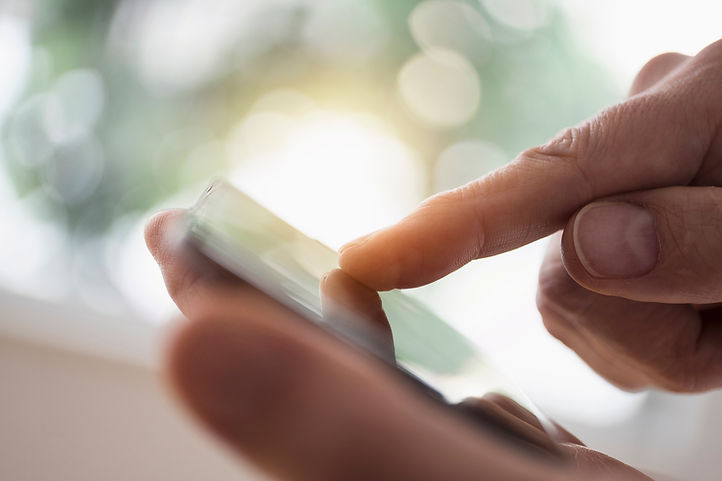
MOBILE DESIGN COURSE
At my institution, there is a need for mobile-friendly online courses. I have developed a training to address this need. My Mobile Design course teaches instructors and course developers how to create Blackboard content that will work well on the Mobile Learn app.
I identified my institution's need for this course when I noticed a growth of student usage of the app, stymied by a lack of mobile-friendly classes. In developing the course, I made sure my assessments, technology implementation, and use of outside content conforms to ISTE standards.
TRAINING OVERVIEW
For this training, I have developed five units. Each unit covers an aspect of mobile design. Topics include mobile-unfriendly tools and practices, and how to build workarounds. Most of the units take advantage of Web 2.0 tools, such as Twitter, wikis, YouTube, and Slideshare. The assessments encourage learners to innovate.
Below, I detail how the course aligns with several ISTE standards.

ISTE 1
LEARNING & CREATIVITY
1A
UNIT 2 DISCUSSION
Learners design a page of information in Blackboard using mobile unfriendly elements. Next, they examine classmates’ pages and suggest ways they can redesign their content to be more mobile friendly.
1B
UNIT 4 DISCUSSION
Learners must use Blackboard's mobile quiz creator to generate mobile-friendly quizzes.
1C
FINAL PROJECT
Learners must devise, discuss, evaluate, and suggest strategies to make content degrade gracefully between web and mobile versions of their courses, and the courses of their peers.
ASSESSMENTS
For this course, I use discussions, mobile-friendly tests, and various
hands-on assignments to assess the progress of my learners. The course models and teaches how to creatively design Blackboard content to be mobile-friendly. It asks learners to devise their own workarounds for objects that will not display well on a mobile device (ISTE 1A).
Additionally, the course engages learners to solve the real-world issue of mobile-unfriendly content in Blackboard courses using digital tools like PDF generators and Blackboard's mobile quiz creator (ISTE 1B).
The course uses collaborative forums to help students reflect on, plan, and understand design strategies that result in mobile-friendly content (ISTE 1C).

ISTE 3
DIGITAL WORK & LEARNING
WEB 2.0 TOOLS
To supplement the text of this course, which consists of Blackboard-generated help material, I created several multimedia presentations using Web 2.0 tools. These presentations demonstrate my fluency in technology systems and transfer of current knowledge of Powerpoint to new technologies, like Slideshare and slideshow-based videos (ISTE 3A).
Furthermore, my Mobile Design course employs Web 2.0 tools to communicate relevant information and ideas effectively to students and peers using a variety of digital age media and formats, including Slideshares, YouTube videos, and podcasts (ISTE 3C).
3A
In Unit 4 of my course, I leveraged my knowledge of Powerpoint to create a Blackboard Mobile Tests video. First, I designed Powerpoint slides. Next, I imported the slides into Windows Movie Maker as video frames. Finally, I added narration and uploaded the video to YouTube.

ISTE 4
DIGITAL CITIZENSHIP & RESPONSIBILITY
CREATIVE COMMONS MATERIAL
Throughout this course, I model safe, legal, and ethical use of digital information and technology, including respect for copyright, intellectual property, and the appropriate documentation of sources (ISTE 4A). I accomplish this by properly citing the source of imagery and music and using only public domain material, as demonstrated in the images below.
4A
 |  |
|---|---|
 |  |

ISTE 5
PRO GROWTH & LEADERSHIP
To create this Mobile Design course, I first had to learn to design for Blackboard Mobile myself. I read through the documentation and designed my own mobile-friendly course. I worked to improve my professional practice and model lifelong learning. Thus, in this course, I exhibit leadership in my institution by promoting and demonstrating the effective use of digital tools and resources.
5A
UNIT 3 SLIDESHARE
I use Slideshare to introduce the concept that not all Blackboard tools are mobile-friendly. In other units, I use wikis and Twitter to connect students to Mobile Support and other resources as well.
5B
COURSE-WIDE ALIGNMENT
Additionally, this course exhibits leadership. It demonstrates a vision of the infusion of mobile design skills and develops the mobile design skills of others. This is evident throughout the course and in my learning objectives:
-
Locate Blackboard Mobile resources
-
Compare and contrast the web and mobile version of a course
-
Identify mobile-friendly Blackboard features and design practices
-
Justify the use of mobile unfriendly features
-
Predict how differences between mobile and web versions of a course affect student understanding
-
Develop mobile-friendly Blackboard content
5D
COURSE-WIDE ALIGNMENT
Finally, the course contributes to the effectiveness, vitality, and self-renewal of the teaching profession and of my school by advocating for mobile-friendly online courses. Again, this is evident throughout the course, my learning objectives, and my target audience: instructors.